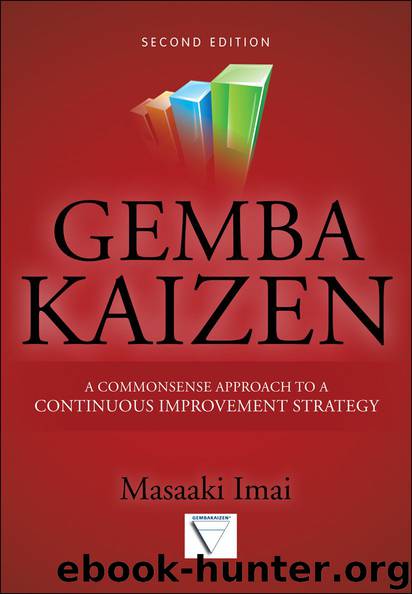Gemba Kaizen: A Commonsense Approach to a Continuous Improvement Strategy, Second Edition by Imai Masaaki

Author:Imai, Masaaki
Language: eng
Format: epub
Publisher: McGraw-Hill Education
Published: 2012-06-22T04:00:00+00:00
CHAPTER THIRTEEN
The CEO’s Role in Kaizen
My next conversation with Art Byrne took place in October 2011 in Tokyo. Byrne had long since retired from Wiremold but had, in his words, “failed retirement” and joined Boston-based J.W. Childs Associates, LP, a private equity firm, as an operating partner. The firm buys companies and subsequently sells them at a profit. Byrne’s role is to improve their operations to increase their value, and kaizen is his secret weapon.
Byrne drives change from the top as he did at Wiremold, sitting as chairman of the board of some of the acquired companies and making kaizen an absolute requirement. This role has allowed him to build a unique track record in using kaizen to build stakeholder value in successive companies. It also has given him a very special understanding of the role of top management in introducing kaizen.
Byrne was in Japan leading a tour of Japanese factories for his portfolio managers so that they could see some good examples of kaizen. This kind of benchmarking tour to Japan is very popular, and at the Kaizen Institute, we have offered this service to our clients for many years. Byrne has a house in Tokyo, and I had the pleasure of visiting him there to have this conversation.
I wanted to know how things had progressed at Wiremold after our last conversation. Byrne gave me a summary of overall improvements from the time he came in as CEO in September 1991 to the sale of the company in July 2000.
Lead time dropped from four to six weeks down to one to two days.
Productivity improved by approximately 162 percent.
Gross profit went from 38 to 51 percent.
Machines changeovers went from three times a week to 20 to 30 times a day.
Inventory turns improved from 3 to 18 times.
Customer service improved from 50 to 98 percent.
Sales grew from $100 million to more than $400 million.
Working capital as a percentage of sales fell from 21.8 to 6.7 percent.
Operating income improved by 14.4 times.
Enterprise value increased from $30 million to $770 million.
Imai: How would you explain the increase in sales volume?
Byrne: During the period I was at Wiremold, we acquired about 21 different companies. And about half our sales growth came through acquisitions and about half through internal growth.
Imai: Did you use kaizen in the companies you acquired?
Byrne: Every company that we acquired—a lot of them were pretty small companies by the way, and some of them were just product lines—every one of them we did kaizen right away. The first week that we got there we started doing kaizen. We wanted to make sure that the people in the new companies that we bought understood that our whole culture was all about removing waste through kaizen, and they were going to be involved in it whether they liked it or not. It was really helpful to do it that way. There was no room for gray areas that might make the new associates nervous.
Imai: As a top manager, what was your role with kaizen?
Byrne: I led all the first kaizen sessions.
Download
This site does not store any files on its server. We only index and link to content provided by other sites. Please contact the content providers to delete copyright contents if any and email us, we'll remove relevant links or contents immediately.
| Automotive | Engineering |
| Transportation |
Whiskies Galore by Ian Buxton(41514)
Introduction to Aircraft Design (Cambridge Aerospace Series) by John P. Fielding(32876)
Small Unmanned Fixed-wing Aircraft Design by Andrew J. Keane Andras Sobester James P. Scanlan & András Sóbester & James P. Scanlan(32560)
Craft Beer for the Homebrewer by Michael Agnew(17920)
Turbulence by E. J. Noyes(7683)
The Complete Stick Figure Physics Tutorials by Allen Sarah(7126)
Kaplan MCAT General Chemistry Review by Kaplan(6572)
The Thirst by Nesbo Jo(6425)
Bad Blood by John Carreyrou(6261)
Modelling of Convective Heat and Mass Transfer in Rotating Flows by Igor V. Shevchuk(6216)
Learning SQL by Alan Beaulieu(6017)
Weapons of Math Destruction by Cathy O'Neil(5807)
Man-made Catastrophes and Risk Information Concealment by Dmitry Chernov & Didier Sornette(5631)
Digital Minimalism by Cal Newport;(5363)
Life 3.0: Being Human in the Age of Artificial Intelligence by Tegmark Max(5169)
iGen by Jean M. Twenge(5145)
Secrets of Antigravity Propulsion: Tesla, UFOs, and Classified Aerospace Technology by Ph.D. Paul A. Laviolette(4964)
Design of Trajectory Optimization Approach for Space Maneuver Vehicle Skip Entry Problems by Runqi Chai & Al Savvaris & Antonios Tsourdos & Senchun Chai(4833)
Electronic Devices & Circuits by Jacob Millman & Christos C. Halkias(4731)
